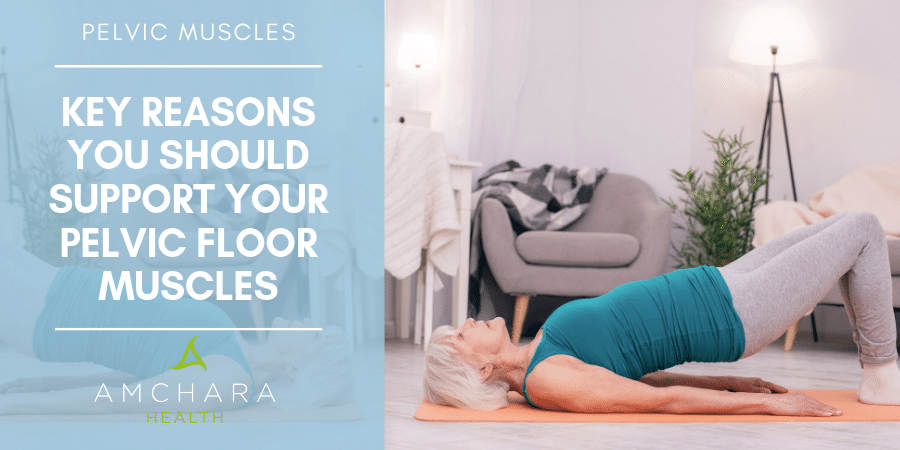Topics Covered in this article:
Pelvic floor muscles make up a sling shaped structure that supports the pelvic organs.
Weakened pelvic floor muscles may occur for a variety of reasons and because many organs lie in the pelvis this can lead to many issues.
We always take an evidence-based approach and aim to provide you with actionable knowledge and tips to help you on your journey to optimal health.
In this article we take a look at the importance of supporting the pelvic floor and how to tighten the muscles effectively.
Urinary Incontinence
It is a common joke amongst women who have had children, or those going through the menopause that laughing too much, sneezing or coughing may cause a ‘little leak’ of urine.
But it is no laughing matter.
Female urinary leakage can range from a few drops right through to complete incontinence.
It is thought that around 3 million people in the UK suffer with urinary incontinence.
There are a variety of different types and around 90% of cases involve stress or urge incontinence (1).
Common causes of weakened pelvic floor exercises include pregnancy and childbirth, surgery such as a hysterectomy, falling hormone levels – as occurs during the menopause – and being overweight.
Bladder muscle overactivity, urinary tract infections, bladder stones and injury may also increase the chances of developing urinary incontinence.
A common therapy for weakened pelvic floor muscles is a form of physiotherapy – commonly referred to as Kegel exercises.
Pelvic floor exercises have shown much benefit in supporting urinary incontinence.
Several studies in women of varying ages show that regular pelvic floor exercises can reduce stress incontinence in nearly 70% of cases (2,3,4,5).
As long as pelvic floor exercises are maintained benefits can be seen even after 10 years (2).
Following the birth of a baby, regular pelvic floor exercise can reduce the chances of urinary incontinence (5), but it seems that doing the same exercises during pregnancy is not as effective.
Children with dysfunctional elimination syndrome, characterised by urinary and bowel incontinence and holding, also show improvements with the use of Kegel exercises (6).
Studies also indicate that bio-feedback enhances the success of doing pelvic floor exercises (7).
Bio-feedback involves internal devices connected to a computer or handheld monitor which sense and rate the strength and accuracy of the muscular contraction.
This feedback can be used to ensure the right group of muscles are worked.
Sexual Function
Menopause can bring many changes and there is often a drop in libido, arousal or enjoyment in sex.
This can have negative effects on relationships and self-esteem.
The pelvic floor muscles are very important when it comes to sex.
Studies indicate that pelvic floor exercises in postmenopausal women increased arousal, satisfaction and orgasm (8).
The benefits are not limited to the postmenopausal period – if the same exercises are done within the first 4 months following childbirth similar enhancements to sexual function are seen (9).
It is not only women who benefit and over a third of men with erectile dysfunction who regularly strengthen the pelvic floor show improvements.
One study showed that after 6 months of pelvic floor exercises 40% of men regained normal erectile function (10).
Bowel Function
Common issues such as constipation and excess straining can also weaken the pelvic floor muscles.
Regular Kegel exercises benefit a variety of different bowel complaints from certain types of constipation (11) through to faecal incontinence (12).
Although the evidence on benefits to faecal incontinence is not as strong as that for urinary incontinence, up to 50% of patients show improvements.
Pulmonary Function
A surprising area that shows improvement from performing regular pelvic floor exercises is pulmonary function.
A study conducted in young, healthy students doing pelvic floor exercises 3 times a day for 4 weeks showed significant improvements in tests evaluating lung function (13).
The exact mechanism isn’t fully known but further studies may be able to show if Kegels exercises are of use for improving respiratory issues.
How to do Kegel Exercises
If this is the first time you have done pelvic floor exercises then it is a good idea to find a relaxed environment.
You may find lying down easier to start with but as you perfect the technique they can be done anywhere anytime.
Step 1. Locate the correct muscles
This is vital as success depends upon clenching and releasing the muscles in the right area.
The pelvic floor muscles are the ones used to stop your urine mid flow.
In order to make sure you can feel the right muscles moving it can be useful to try stopping your urine mid flow once or twice.
This is only to be used for locating the muscles, do not continue to do this regularly as incomplete emptying of the bladder can lead to a urinary tract infection.
Another way to test if you have right muscles is to clench the muscles that you use to stop yourself from passing gas when in public!
Now you have located the muscles it is time to move on to step 2.
Step 2. Perfect your technique
Practice makes perfect. Tighten the pelvic floor muscles and hold for 5 seconds, then relax for 5 seconds.
Aim for 5 times in a row. If you feel comfortable then increase the contraction time to 10 seconds and relax for 10 seconds.
Keep focused on the pelvic floor muscles and avoid tensing muscles in the abdomen, buttocks or thigh.
Step 3. Make it part of your routine
Once you are happy with the ‘squeeze and release’ technique, aim to make it part of your daily life, much like brushing your teeth.
In fact, you can do it whilst brushing your teeth, before you get out of bed, whilst washing up or even when you are having meals.
Making it a regular occurrence alongside something you already do every day makes it easier to remember.
Step 4. Stick to your method
Often there are different suggestions on how long to hold contractions for or how many to do.
Do you split it and do it twice a day? Or just once a day?
There can be conflicting advice as to whether it is better to do them in the morning or evening.
The key is to stick to what works for you.
As a guide, pelvic floor exercises seem to be most useful when they are done on a daily basis, ideally with 3 sets of 10 contractions with a 10 second interval.
Another method that may be easier to remember is the 4-3-2 method (14).
This comprises of four sets of exercises each with three contractions lasting for 2 breaths (around 10 seconds) with a 10 second (2 breath) break in between.
This can be done once or twice a day.
So, 4 sets of exercises, 3 contractions in each set, hold for 2 breaths.
Now you know the benefits of exercising the pelvic floor and the technique there really is no excuse not to be giving them a go.
This doesn’t need to be the end of the article. With your help let’s continue the conversation.
Did you find this article useful?
Please share your thoughts in the comments.
READ THIS NEXT:




